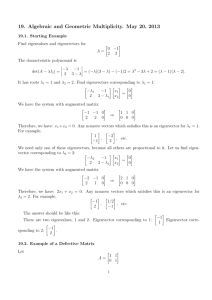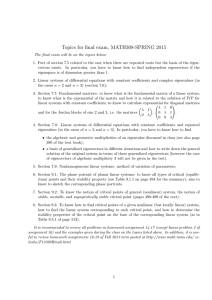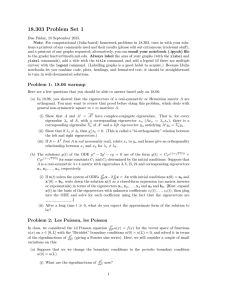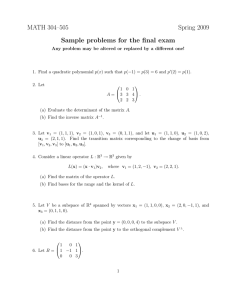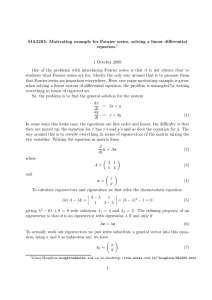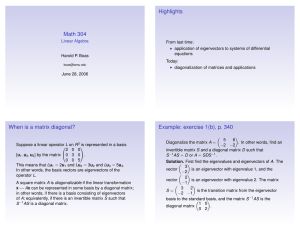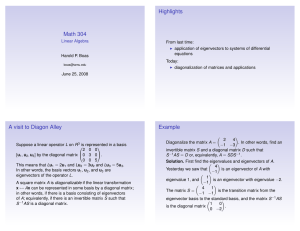Mathematics 307|December 6, 1995
advertisement
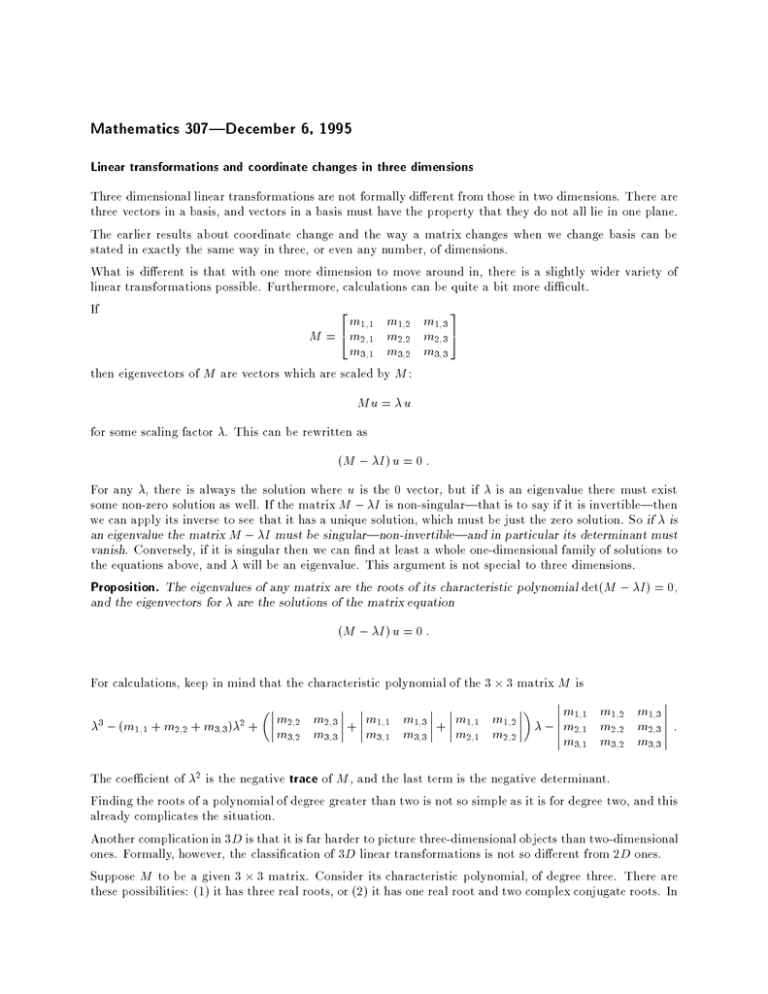
Mathematics 307|December 6, 1995 Linear transformations and coordinate changes in three dimensions Three dimensional linear transformations are not formally dierent from those in two dimensions. There are three vectors in a basis, and vectors in a basis must have the property that they do not all lie in one plane. The earlier results about coordinate change and the way a matrix changes when we change basis can be stated in exactly the same way in three, or even any number, of dimensions. What is dierent is that with one more dimension to move around in, there is a slightly wider variety of linear transformations possible. Furthermore, calculations can be quite a bit more dicult. If 2 3 m1 1 m1 2 m1 3 M = 4 m2 1 m2 2 m2 3 5 m3 1 m3 2 m3 3 then eigenvectors of M are vectors which are scaled by M: ; ; ; ; ; ; ; ; ; Mu = u for some scaling factor . This can be rewritten as (M , I) u = 0 : For any , there is always the solution where u is the 0 vector, but if is an eigenvalue there must exist some non-zero solution as well. If the matrix M , I is non-singular|that is to say if it is invertible|then we can apply its inverse to see that it has a unique solution, which must be just the zero solution. So if is an eigenvalue the matrix M , I must be singular|non-invertible|and in particular its determinant must vanish. Conversely, if it is singular then we can nd at least a whole one-dimensional family of solutions to the equations above, and will be an eigenvalue. This argument is not special to three dimensions. Proposition. The eigenvalues of any matrix are the roots of its characteristic polynomial det(M , I) = 0, and the eigenvectors for are the solutions of the matrix equation (M , I) u = 0 : For calculations, keep in mind that the characteristic polynomial of the 3 3 matrix M is 3 , (m1 1 + m2 2 + m3 3)2 + ; ; ; 1;3 1;2 m2 2 m2 3 + m1 1 m + m1 1 m m3 2 m3 3 m3 1 m3 3 m2 1 m2 2 ; ; ; ; ; ; ; ; ; ; m1 1 m1 2 m1 3 , m2 1 m2 2 m2 3 : m3 1 m3 2 m3 3 ; ; ; ; ; ; ; ; ; The coecient of 2 is the negative trace of M, and the last term is the negative determinant. Finding the roots of a polynomial of degree greater than two is not so simple as it is for degree two, and this already complicates the situation. Another complication in 3D is that it is far harder to picture three-dimensional objects than two-dimensional ones. Formally, however, the classication of 3D linear transformations is not so dierent from 2D ones. Suppose M to be a given 3 3 matrix. Consider its characteristic polynomial, of degree three. There are these possibilities: (1) it has three real roots, or (2) it has one real root and two complex conjugate roots. In Linear transformations and coordinate changes in three dimensions 2 the rst case one of several possibilities may occur: (a) The three real roots are all distinct. In this case we can nd three linearly independent eigenvectors. (b) Two of the roots are the same. This breaks up further into cases: (i) we can nd two linearly independent eigenvectors for the repeated root; (ii) we cannot. (c) All three of the roots are the same. In this case we have either (i) there exist three linearly independent eigenvectors for this single root; (ii) there exists only two linearly independent eigenvectors for it; (iii) there exists only a line of eigenvectors for it. We can exhibit examples of each kind of behaviour, which classify all matrices up to similarity. In the rst set of examples, a, b, c are meant to be distinct real numbers. Example. (1)(a) 2 3 a 0 0 S = 40 b 05 0 0 c Matrices similar to one of this type are characterized by the property that they have three distinct real eigenvalues. If X = [ v1 v2 v3 ] where the v are eigenvectors for a etc, then X ,1 MX = S. Example. (1)(b)(i) 2 3 a 0 0 S = 40 a 05 0 0 b Matrices similar to this matrix are those with two real eigenvalues a and b, where a is a repeated root with multiplicity two, and we can can nd two linearly independent eigenvectors for a. In other words, the matrix M , aI has rank one (and M , bI has rank two). Again, if we make up a matrix X whose columns are independent eigenvectors, then X ,1 MX = S. Example. (1)(b)(ii) 2 3 a 1 0 S = 40 a 05 0 0 b Here a is a repeated root, but M , aI has rank two, so we can only nd a one-dimensional line of eigenvectors. Let v3 be an eigenvector for b, v1 one for a. We want to nd a third vector v2 such that the matrix of M with respect to the basis v1 , v2 , v3 is S. This means that i Mv1 = av1 ; Mv2 = av2 + v1 ; Mv3 = bv3 : In other words (M , aI)v2 = v1 : So we must solve this equation for v1 . This will be possible because M , aI has rank two. Proposition. Suppose that M has eigenvalues a 6= b, with a a repeated root. If we can nd only one independent eigenvector for a, then M is similar to S. Let v1 be an eigenvector for a, v3 one for b. We know that the linear transformation associated to M takes the line through v3 into itself. I claim that we can nd a two dimensional plane which intersects this line only at the origin, and which is taken into itself by M. In fact, if we let u2 be any vector independent of v1 and v3 then the matrix of T with respect to the basis v1 , u2, v3 looks like this: 2 3 a a1 2 0 4 0 a2 2 05 0 a2 3 b ; ; ; Linear transformations and coordinate changes in three dimensions 3 The characteristic polynomial of M is then , b times that of the 2 2 matrix A in the upper left, which therefore must be ( , a)2 , since a is a repeated root. So a2 2 = a, and our matrix is ; 2 3 a a1 2 0 0 a 05 0 a2 3 b ; 4 ; We have Tu2 = au2 + a1 2v1 + a3 2v3 I claim now that we can replace u2 by a new vector of the form u2 + xv3 so that the new matrix becomes 2 3 a a1 2 0 40 a 05 0 0 b ; ; ; (with a dierent a1 2). We have ; T(u2 + xv3 ) = au2 + a1 2v1 + a3 2v3 + bxv3 = a(u2 + xv3 ) , axv3 + a1 2v1 + a3 2v3 + bxv3 which means that we must solve (b , a)x + a3 2 = 0 which we can do because a 6= b. From here we make a simple scale change of v1 to get the matrix 2 3 a 1 0 40 a 05 0 0 b ; ; ; ; ; Example. (1)(c)(i) 2 3 a 0 0 S = 40 a 05 0 0 a In order for M to be similar to S, M must in fact be S itself. Example. (1)(c)(ii) 2 3 a 1 0 40 a 05 0 0 a This case is distinguished by the property that M , aI has rank one. Suppose we can nd independent eigenvectors v1 and v2 , and let u3 be any third independent vector. Then the matrix in this basis is 3 2 a 0 a1 3 40 a a 235 0 0 a where a1 3 and a2 3 are not both 0. The vector a1 3v1 + a2 3v2 is therefore non-zero, and we can replace one of v1 or v2 , say v1 , by it to get a new basis, with Tv3 = v3 + v1 . For the basis v1 , v3, v2 we get the matrix S. Let me do an example. Suppose 2 3 ,2 ,1 ,2 M = 4 ,3 0 , 2 5 6 2 5 ; ; ; ; ; ; Linear transformations and coordinate changes in three dimensions 4 The characteristic polynomial is 3 , 32 + 3 , 1 and it has a single root = 1. The matrix M , I is ,3 ,1 ,2 4 ,3 ,1 ,2 5 2 3 6 2 4 It has rank one since all rows are multiples of the rst. So the eigenvector equation is 3x + y + 2z = 0 and the eigenvectors make up a plane. We can nd two linearly independent ones. If we set x = 0 we get (0; ,2; 1) and if we set y = 0 we get (2; 0; ,3). We can choose u3 = (0; 0; 1). The matrix in this coordinate system is 2 3 1 0 1 4 0 1 ,1 5 0 0 1 this says that Tu3 = u3 , v2 +v1 . We therefore set v3 = u3, and replace v2 by ,v2 +v1 . Then Tv3 = v3 +v2 , and still Tv2 = v2 . Example. (1)(c)(iii) 2 3 a 1 0 S = 40 a 15 0 0 a This case is characterized by the condition that the rank of M , aI is two. If we choose v1 to be an eigenvector and u2 and u3 independent, the matrix becomes 2 3 a a1 2 a1 3 4 0 a2 2 a2 3 5 0 a3 2 a3 3 ; ; ; ; ; ; The matrix in the lower right must have an eigenvector, say with coordinates (x; y). then if we replace u2 by xu2 + yu3 the matrix will become 2 3 a a1 2 a1 3 40 a a2 3 5 0 0 a Replacing v1 we can make this 2 3 a 1 a1 3 40 a a 235 0 0 a and nally replacing v2 we can make it 2 3 a 1 0 40 a 15 0 0 a ; ; ; ; ; Suppose ,4 ,3 ,4 M = 4 ,4 ,1 ,3 5 2 3 9 5 8 Linear transformations and coordinate changes in three dimensions The characteristic polynomial is again with repeated roots. Here which reduces to 5 3 , 32 + 3 , 1 ,5 ,3 ,4 M , I = 4 ,4 ,2 ,3 5 2 3 9 2 5 7 3 9 5 7 40 2 15 0 0 0 So the eigenvectors are solutions of the pair of equations 9x + 5y + 7z = 0 2y + z = 0 If we set z = 1 we get y = ,1=2, 9x = ,5y , 7z, x = ,1=2. So (,1; ,1; 2) is an eigenvector. Set v1 equal to it. For v2 and v3 we want (M , I)v2 = v1 (M , I)v3 = v2 which we can solve in turn. Each has many solutions, but at least one. Example. (2) 2 3 a ,b 0 S = 4 b a 05 0 0 c Here we may as well assume b > 0. This case is characterized by the property that M has one real eigenvalue and two conjugate complex ones. We can nd X in this case just as we did for the two dimensional case: let U be a matrix whose columns are the eigenvectors [uuv], and 2 3 1 1 0 U0 = 4 ,i i 0 5 0 0 1 and set X = UU0,1. The reasoning above, summarized, shows that in fact Proposition. Every 3D matrix is similar to exactly one of the types above. There are again a small number of types. The basic idea is that we can extend the two-dimensional types to three dimensions by scaling along the third dimension, which gives us most of the typoes above, or we can add one new type which is the combination of a uniform scale change with a new type of shear. In other words, again the basic classication is into scale changes, rotations, and shears, but with essentially two kinds of shear, illustrated by these examples: 2 3 2 3 1 1 0 1 1 0 40 1 05; 40 1 15 0 0 1 0 0 1 The variety of each type is larger, too. For example, true rotations in 3D are specied by a choice of oriented axis and angle of rotation.

